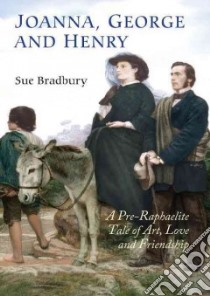- Libreria
- >
- Libri in lingua
- >
- Arte e fotografia
- >
- Forme d’arte
Joanna, George, and Henry - 9781843836179
Un libro in lingua di Sue Bradbury edito da Boydell Pr, 2012
- € 41.60
- Il prezzo è variabile in funzione del cambio della valuta d’origine
When the transcript of these letters came to light ten years ago, no one could have imagined the drama within. They were family letters: letters from a young woman to her brother and later to her suitor - of interest chiefly because all three were painters, and all were active participants in the youthful Pre-Raphaelite revolution that swept England in the 1850s. At the very least, perhaps, such letters would provide the odd additional insight to a well-trodden story? They turned out to be a revelation - giving not only a comprehensive picture of what it was like to be an artist in the mid-19th century, but containing within them a powerful family drama and a most unusual love story. It is a love story, moreover, told largely from a woman's point of view. Joanna Boyce's suitor, Henry Wells, was an accomplished miniaturist when he first met George Boyce on a sketching holiday in Wales. George was struggling to become a water-colourist. His sister, five years younger, champed at his heels - already a dedicated painter who had convinced herself that she could not combine being a serious artist with being a wife and mother. This did not stop Henry falling in love with her, and during their protracted on-off engagement, they continued to correspond with each other, thus incurring the wrath of Joanna's mother. Yet her dedication to her art was absolute: she studied in Paris under Thomas Couture, reviewed exhibitions for the influential Saturday Review, and had her first painting exhibited at the Academy when she was only 24. She was headstrong, self-critical, opinionated and teasing - 'an artist with her pen as well as her brush'. She died tragically young. Between them, Joanna, George and Henry knew all the artistic luminaries of the day, among them Ruskin, Millais and Rossetti (with whom George shared a great deal, including mistresses). They wrote to each other all the time - not just about art, but about their friends, their families, their favourite books, their travels, their illnesses, their passions and their quarrels. They gossiped and exchanged anecdotes. They consulted mesmerists and clairvoyants. They witnessed the Great Exhibition and the funerals of Turner and the Duke of Wellington. They agitated for news of the Crimean War and the Indian Mutiny. In this book, they tell their story in their own vivid words - a story which portrays the age in which they lived and the powerful drama of their emotional and professional lives.
Informazioni bibliografiche
- Titolo del Libro in lingua: Joanna, George, and Henry
- Sottotitolo: A Pre-raphaelite Tale of Art, Love and Friendship
- Lingua: English
- Autore: Sue Bradbury
- Editore: Boydell Pr
- Collana: Boydell Pr (Hardcover)
- Data di Pubblicazione: 16 Maggio '12
- Genere: BIOGRAPHY and AUTOBIOGRAPHY
- Pagine: 320
- ISBN-10: 1843836173
- EAN-13: 9781843836179


